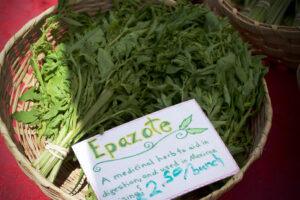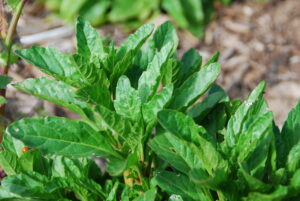Epazote
Overview
Epazote is an herb cherished for its culinary and medicinal properties, yet also often seen as a weed. Native to South and Central America, this versatile plant is appreciated for its ability to add unique flavor to dishes and for its traditional use as a natural remedy against parasites. Its distinctive appearance, with soft, notched leaves and a bushy stature, makes it a notable addition to any garden.

Characteristics
Known for its pungent aroma, traditional medicinal properties in expelling parasitic worms, and culinary uses as a flavoring herb in various diets.
Region
Native to South and Central America, commonly grown in USDA zones 8-10.
Natural Habitat
Typically found in sunny fields, roadsides, and waste areas.
Cultivation
Full sun to partial shade, moderate watering, and well-draining soil.
Uses and Benefits
Epazote shines both in the kitchen and in traditional medicine. Its unique, slightly piquant flavor makes it ideal for infusing dishes, particularly in Mexican cuisine. Think hearty beans and savory moles that seek an authentic touch. In your pot, it infuses a distinct taste that no other herb can mimic, and it’s easily adaptable to various diets, fitting in seamlessly with vegan, vegetarian, paleo, or gluten-free meal plans5.
From a medicinal standpoint, the ancients weren’t wrong about its benefits; Dysphania ambrosioides has been used for centuries to combat intestinal parasites1. While contemporary science hasn’t fully endorsed all traditional uses, there’s something to be said about the staying power of natural remedies. Epazote’s potential benefits include:
- Alleviating digestive issues
- Reducing bloating and gas
- Combating intestinal parasites
- Providing antioxidants and essential oils
Whether you’re spicing up dinner or interested in historical botanical remedies, Epazote is a multifaceted herb that might just deserve a spot in your garden and on your spice rack. Its versatility and potential health benefits make it a valuable addition to any nature-conscious household.

Cultivation Tips
Cultivating Dysphania ambrosioides in your garden is a breeze, as this tenacious herb requires minimal fuss. To ensure your Epazote thrives, follow these simple tips:
- Sunlight: Epazote adores basking in full sunlight, so choose a spot where it can soak up the sun’s warmth.
- Soil: While not particularly picky about soil type, Epazote appreciates well-draining ground to prevent root rot.
- Watering: Embrace a tough-love approach when it comes to watering, as Epazote prefers drier conditions. Avoid overwatering to keep your plant healthy and happy.
- Climate: In areas prone to freezing temperatures, plant Epazote annually or grow it in a container that can be brought indoors during the colder months.
- Space: Give your Epazote room to grow, as it can reach impressive heights of up to four feet.
When it comes to companion planting, Epazote is an amiable neighbor that seems to get along with everyone. Feel free to experiment with different plant combinations in your herb garden and discover what works best for you.
While Epazote is generally trouble-free, keep an eye out for common pests like aphids. To prevent an Epazote takeover, harvest the herb before it goes to seed, unless you don’t mind a little extra abundance in your garden!4 5
Seasonal Considerations
Epazote is a resilient herb that can thrive in your garden with minimal effort. To ensure your Epazote plant flourishes, provide it with full sunlight – it relishes basking in the warmth, just like we do on a sunny day! This herb isn’t particularly fussy about soil, but it does appreciate well-draining ground.
When it comes to watering, Epazote prefers a more hands-off approach:
- Avoid overwatering, as this herb prefers drier conditions
- Allowing the soil to dry out between watering helps prevent root rot
If you live in an area that experiences freezing temperatures, don’t worry – you have options:
- Plant Epazote annually
- Use a container to bring it indoors when cold weather arrives
When it comes to space, Epazote likes room to grow, as it can reach heights of up to four feet. In terms of companions, Epazote is like the friendly neighbor who gets along with everyone – feel free to experiment with different plant pairings in your herb garden.
While Epazote is generally trouble-free, keep an eye out for common pests like aphids. Remember to harvest the herb before it goes to seed, unless you don’t mind an Epazote takeover in your garden, which might be too much of a good thing4 5.

Issues and Troubleshooting
While Epazote (Dysphania ambrosioides) is a resilient herb, it can encounter some challenges during growth. One common issue is its tendency to spread rapidly, potentially becoming invasive in the garden. To keep Epazote under control, consider planting it in containers or raised beds to limit its spread.
On the other hand, Epazote is sensitive to overwatering, which can lead to root rot. To prevent this issue, ensure the plant is grown in well-draining soil and water moderately. Allow the soil to dry out slightly between watering sessions to maintain healthy roots.
Although pests are not typically a major concern for Epazote, it’s still important to monitor for common insects such as:
- Aphids
- Spider mites
- Whiteflies
If you notice any pests, address the problem promptly using natural or organic pest control methods to minimize damage to the plant.
Adequate sunlight is crucial for Epazote to thrive. Without sufficient light, the plant may become leggy or produce fewer flavorful leaves. To encourage lush growth and maintain the potency of its leaves, grow Epazote in a location that receives full sun for at least 6 hours per day.
If you’re growing Epazote for culinary purposes, remember to harvest the leaves regularly to promote new growth and prevent the plant from going to seed too early2. By addressing these potential issues and providing the right growing conditions, you can enjoy a bountiful and flavorful Epazote harvest.
History and Folklore
Epazote, steeped in intrigue and tradition, is intricately woven into the tapestry of Mayan culture. The herb played a key role in the Mayan way of life for its believed ability to expel parasitic worms—a property that earned it the name “wormseed.” Epazote’s use extended beyond medicinal purposes, as it was also a staple in Mayan cuisine.
The herb’s journey didn’t stop at the borders of Central America. In the 17th century, European explorers, enamored by its potential, brought epazote back from Mexico1. As it traveled across oceans, so too did tales of its powers and uses. The stories of epazote’s medicinal properties and unique flavor profile spread, captivating the minds of people in new lands.
As epazote made its way into new cultures, it became firmly embedded in their folklore. People eagerly shared stories of the herb’s ability to ward off parasites and add a distinct flavor to dishes. The tales of epazote’s powers and uses were passed down through generations, solidifying its place in the traditions of various communities around the world.
Today, epazote remains an important part of many cultures, particularly in Mexican and Central American cuisine. Its rich history and the stories surrounding its uses continue to captivate people, making it a beloved herb with a fascinating past that spans centuries and continents.
References
1. MorningChores, https://morningchores.com/growing-epazote/
2. The Spruce, https://www.thespruce.com/epazote-plant-growing-guide-5496820
3. Gardener’s Path, https://gardenerspath.com/plants/herbs/grow-epazote/
4. NatashaLH, https://natashalh.com/growing-epazote/
5. The Spruce Eats, https://www.thespruceeats.com/what-is-epazote-4126810
Image Credit: danbruell Attribution-NonCommercial-ShareAlike License
Image Credit: danbruell Attribution-NonCommercial-ShareAlike License
Image Credit: Suzies Farm Attribution-NonCommercial-NoDerivs License
Nicolas Duval
Nicolas is a passionate advocate for nature and the art of wildcrafting. His dedication shines through in Wildcraftia, a website he meticulously crafted to serve as a haven for nature enthusiasts worldwide. Driven by a deep appreciation for nature’s connection to humanity, Nicolas embarked on his journey in 2011 with SmokableHerbs, a platform showcasing his love for nature’s bounty. Building upon this foundation, he established Smokably, a thriving online store offering premium herbs and blends to a global audience.
